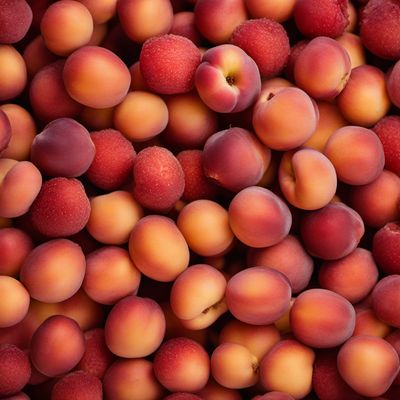
Ingredient
Nectarines
Juicy Summer Delights
Nectarines are a type of stone fruit that belong to the same species as peaches. They have a smooth, thin skin that ranges in color from yellow to red, and their flesh is juicy and aromatic. The flavor of nectarines is sweet and slightly tangy, with a hint of acidity. They can be eaten fresh, sliced into salads, grilled, baked into desserts, or used in jams and preserves.
Origins and history
Nectarines are believed to have originated in China over 2,000 years ago. They were later introduced to ancient Persia (modern-day Iran) and then spread to Europe via trade routes. Today, nectarines are widely cultivated in many countries with suitable climates, including the United States, Spain, Italy, and Greece. They are especially popular during the summer months when they are at their peak.
Nutritional information
Nectarines are low in calories and a good source of dietary fiber, vitamins A and C, and potassium. They also contain antioxidants that help protect against oxidative stress and inflammation. With their high water content, nectarines are a hydrating fruit choice.
Allergens
Nectarines may cause allergic reactions in individuals with sensitivities to stone fruits, such as peaches or cherries. If you have known allergies, it is advisable to consult with a healthcare professional before consuming nectarines or any related fruits.
How to select
When selecting nectarines, look for fruits that are firm yet slightly yielding to gentle pressure. Avoid nectarines that are overly soft or have bruised or wrinkled skin. The skin should be smooth and free from blemishes. The color of the skin can vary depending on the variety, but it should be vibrant and without any green patches.
Storage recommendations
To maintain the freshness and flavor of nectarines, store them at room temperature until they are fully ripe. Once ripe, they can be refrigerated to prolong their shelf life. However, refrigeration may affect the texture and flavor, so it is best to consume them within a few days of refrigeration.
How to produce
Nectarine trees can be grown by amateur gardeners in regions with suitable climates. They require well-drained soil, full sun exposure, and regular watering. Pruning and thinning of the branches may be necessary to promote healthy growth and fruit production.
Preparation tips
Nectarines can be enjoyed fresh as a snack, sliced into salads, or used in a variety of culinary preparations. They can be grilled to enhance their natural sweetness, baked into pies or tarts, or blended into smoothies. Nectarines also make a delicious addition to jams, jellies, and fruit preserves.
Substitutions
Peaches can be used as a suitable substitute for nectarines, as they belong to the same species and have similar characteristics. However, peaches have a fuzzy skin compared to the smooth skin of nectarines. Other alternatives include apricots or plums, which share a similar flavor profile and texture.
Culinary uses
Nectarines are commonly used in both sweet and savory dishes. They can be used in fruit salads, salsas, chutneys, or as a topping for yogurt or ice cream. Nectarines are also a popular ingredient in baked goods, such as pies, cobblers, and crumbles. In addition, they can be grilled and served alongside grilled meats or incorporated into marinades and glazes.
Availability
Nectarines are widely available in countries with suitable climates for cultivation. They are commonly found in North America, Europe, and parts of Asia. The specific varieties and availability may vary depending on the region and local growing seasons.

